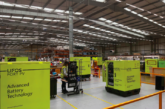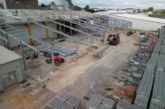Nick Russell, Director, Thomasons, says that the construction industry needs to have a more open discussion about brownfield.
The Campaign to Protect Rural England (CPRE) published research this spring revealing that we are currently sitting on areas of brownfield collectively the size of Birmingham (around 26,000 hectares). Over half of this is ready for immediate development. Here exists a golden opportunity, from addressing the current housing crisis and overhauling our tired infrastructure network, to revitalising our struggling high streets and re-empowering local government.
It’s a positive vision, but first things first, the construction industry needs to have a more open discussion about brownfield sites and actively improve public and investor understanding of how these areas can be utilised.
Presently we are faced with a number of hurdles. Chief amongst these is an attitude of short-termism. On face value, building on greenfield can seem like the most cost-effective option; you’re not confronted with the initial, significant expense of clearing land and managing contaminated materials. However, often it’s more beneficial and less wasteful to spend more at first to build sustainable structures with a long lifespan or retrofit a structurally sound building which could be given a new lease of life.
This raises further questions concerning our understanding of the term ‘value’ and how it relates to our client and end users as opposed to shareholders alone. Of course, I’m not suggesting that construction companies should not seek to turn a profit, but that, perhaps, we could start adopting a more holistic approach to the work we do.
Rethinking green
‘Sustainability’, which has to go hand in hand with ‘value’ when discussing brownfield, is another misunderstood term. The whole drive to build on greenfield sites appears to be a regressive solution to our current needs, especially when you consider CPRE’s finding.
What do we mean by sustainability? Is it merely making sure a building is as ecologically friendly as possible? Surely the term also applies to delivering buildings which stand the test of time and equally structures which strengthen and benefit the local community. It’s time we empowered this word with a richer meaning and applied it to our standpoint on brownfield.
All too often, buildings with an existing embodied carbon are replaced with a new development. Demolition might seem a safe option but is not always appropriate for the local area or beneficial to the welfare of local residents and workers. Superficially, it’s more financially prudent, but as we well know new buildings require further embodied carbon and environmental disruption.
Waste not, want not
Looking beyond refurbishment, and concentrating on former industrial sites where contamination exists, the current wisdom is to leave these areas as they are and to manage the pollutants, opposed to excavating and removing them. Arising from necessity, as few places in the UK and Ireland accept and process this type of waste, this approach has encouraged us to become more creative.
There are so many solutions at our disposal, particularly in how we handle ‘pollution linkage’. This ranges from covering a contaminated space with a suitable thickness of inert material to rethinking the type of building which occupies the plot (e.g. housing vs. commercial/retail). Alternatively we can use advanced cleaning techniques, rather than removing the materials and simply relocating them elsewhere.
Overall, we need to adopt a more holistic approach, taking the whole lifespan of a building into consideration, as well as its impact on the local community. More joined-up thinking is required.
Government has a role to play here as well, ensuring that we have appropriately funded local authorities who aren’t solely focused on balancing the books.
Making best use of the structures and materials available to us helps build stronger communities within existing ones, offering an economic and socially responsible solution to the current problem, rather than establishing new ones.









